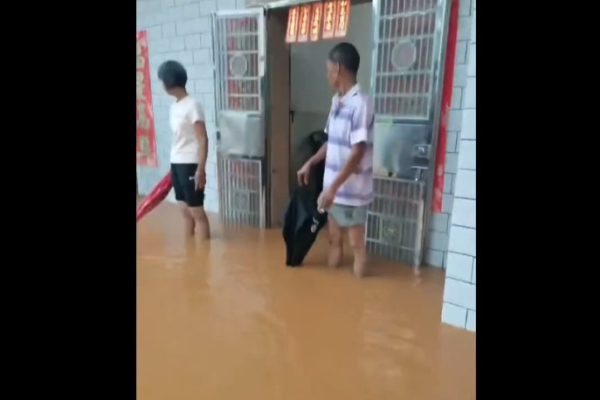On July 26, Typhoon “Kemi”, also known as “Gemei”, moved from Fujian to Jiangxi, causing heavy rainfall in Guangdong, Fujian, Zhejiang, Jiangxi, and other areas. Serious disasters occurred in many places in Guangdong due to the typhoon’s impact.
Influenced by the typhoon, on July 26, Heyuan, Meizhou, and eastern cities and counties in Guangdong experienced heavy to severe rainfall, while Chaozhou and Jieyang saw localized extremely heavy rainfall. Some river stations exceeded the warning water levels. By 7 p.m. on the 26th, Guangdong Province initiated a level III flood emergency response and maintained a level IV wind emergency response. Officials stated that 90,809 people were relocated province-wide, with 87,367 people moved in Meizhou.
Videos shared by netizens showed that the heavy rainfall in Meizhou caused severe flooding in various areas, with inner-urban flooding in multiple locations. The floodwaters submerged Meizhou City, Wuhua County in Meizhou City, and Ning’s streets, with some areas having floodwaters over bridges and water entering homes, with many vehicles on the streets immersed in water.
Netizens expressed concern, with comments like, “This is the first time my hometown Wuhua in Meizhou has experienced such severe floods.” “I never imagined the disaster would come so close to me. Overnight, my hometown was flooded, worrying many.” “This flood is like a game of squatting – one squat after another.”
According to the meteorological department’s forecast, as of 8:30 a.m. on the 27th, 17 cities and counties in Guangdong issued a red alert for heavy rain, while 24 cities and counties issued an orange alert, affecting various areas, including Guangzhou, Huizhou, and Meizhou. Additionally, 72 thunderstorm and strong wind warnings are currently in effect.
From July 27 to 28, “Gemei” will continue to move north at a speed of 15 to 20 kilometers per hour, with the heavy rainfall gradually shifting northwards. As a result, Jiangxi, Hunan, Hubei, as well as parts of the Yellow River and Northern China will experience heavy rainfall, with some areas facing extremely heavy rainfall in Hunan. Furthermore, the cold trough on the northern side of “Gemei” will extend northward, leading to heavy rainfall in the Yellow River, Northern China, and Northeast China regions consecutively.

